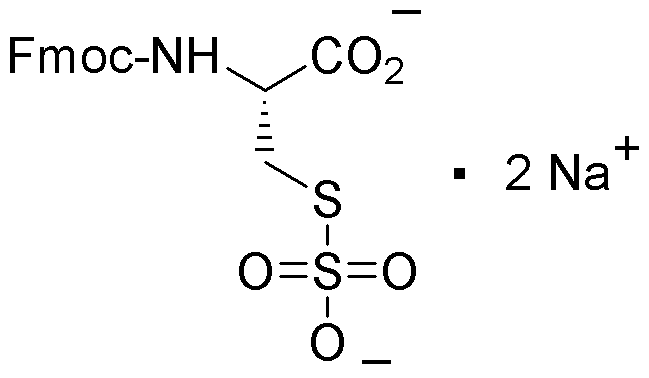Fmoc-S-sulfo-L-cysteine disodium is widely utilized in research focused on:
- Peptide Synthesis: This compound serves as a key building block in the synthesis of peptides, particularly in solid-phase peptide synthesis, enabling the creation of complex and functional peptides for various applications.
- Drug Development: It plays a crucial role in developing novel therapeutics, especially in targeting specific proteins, which is essential in the pharmaceutical industry for creating effective drugs.
- Bioconjugation: Researchers use it for bioconjugation processes, allowing the attachment of biomolecules to surfaces or other molecules, enhancing the efficacy of diagnostics and therapeutics.
- Protein Engineering: The compound is valuable in protein engineering, facilitating the introduction of specific functionalities in proteins, which can improve their stability and activity in various applications.
- Analytical Chemistry: It is utilized in analytical methods, such as mass spectrometry, to improve the detection and characterization of biomolecules, providing researchers with detailed insights into molecular structures.
General Information
Properties
Safety and Regulations
Applications
Fmoc-S-sulfo-L-cysteine disodium is widely utilized in research focused on:
- Peptide Synthesis: This compound serves as a key building block in the synthesis of peptides, particularly in solid-phase peptide synthesis, enabling the creation of complex and functional peptides for various applications.
- Drug Development: It plays a crucial role in developing novel therapeutics, especially in targeting specific proteins, which is essential in the pharmaceutical industry for creating effective drugs.
- Bioconjugation: Researchers use it for bioconjugation processes, allowing the attachment of biomolecules to surfaces or other molecules, enhancing the efficacy of diagnostics and therapeutics.
- Protein Engineering: The compound is valuable in protein engineering, facilitating the introduction of specific functionalities in proteins, which can improve their stability and activity in various applications.
- Analytical Chemistry: It is utilized in analytical methods, such as mass spectrometry, to improve the detection and characterization of biomolecules, providing researchers with detailed insights into molecular structures.
Documents
Safety Data Sheets (SDS)
The SDS provides comprehensive safety information on handling, storage, and disposal of the product.
Product Specification (PS)
The PS provides a comprehensive breakdown of the product’s properties, including chemical composition, physical state, purity, and storage requirements. It also details acceptable quality ranges and the product's intended applications.
Certificates of Analysis (COA)
Search for Certificates of Analysis (COA) by entering the products Lot Number. Lot and Batch Numbers can be found on a product’s label following the words ‘Lot’ or ‘Batch’.
Número de catálogo
Número de lote/lote
Certificates Of Origin (COO)
This COO confirms the country where the product was manufactured, and also details the materials and components used in it and whether it is derived from natural, synthetic, or other specific sources. This certificate may be required for customs, trade, and regulatory compliance.
Número de catálogo
Número de lote/lote
Safety Data Sheets (SDS)
The SDS provides comprehensive safety information on handling, storage, and disposal of the product.
DownloadProduct Specification (PS)
The PS provides a comprehensive breakdown of the product’s properties, including chemical composition, physical state, purity, and storage requirements. It also details acceptable quality ranges and the product's intended applications.
DownloadCertificates of Analysis (COA)
Search for Certificates of Analysis (COA) by entering the products Lot Number. Lot and Batch Numbers can be found on a product’s label following the words ‘Lot’ or ‘Batch’.
Número de catálogo
Número de lote/lote
Certificates Of Origin (COO)
This COO confirms the country where the product was manufactured, and also details the materials and components used in it and whether it is derived from natural, synthetic, or other specific sources. This certificate may be required for customs, trade, and regulatory compliance.


